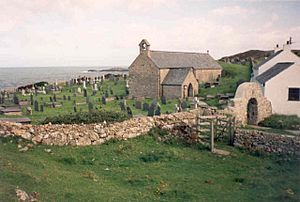St Padrig's Church, Llanbadrig facts for kids
Quick facts for kids St Padrig's Church |
|
|---|---|
 |
|
| Country | Wales, United Kingdom |
| Denomination | Church in Wales |
| Architecture | |
| Heritage designation | Grade II* |
| Designated | 5 December 1970 |
| Architectural type | Church |
| Style | Medieval |
St Padrig's Church is an old church found in the small village of Llanbadrig on Anglesey, an island off the coast of Wales. This church was likely built way back in the 1100s. It got some updates in the 1800s. On December 5, 1970, it was officially recognized as a special building, called a Grade II* listed building. This means it's an important historical place that needs to be protected.
Contents
History of St Padrig's Church
The Legend of Saint Patrick
There's a cool story about how this church came to be. It's said that Saint Patrick, a very famous saint, was sent to Ireland in the 400s. His job was to teach people about Christianity. On his way back, his ship crashed near a tiny island called Middle Mouse (or Ynys Badrig). This island is about half a mile from the northern coast of Anglesey.
Saint Patrick found a safe cave on the island. When he finally made it to the mainland of Anglesey, he built a church. He built it high up on the cliffs to say thank you for being safe.
Building the Stone Church
The first church Saint Patrick built was made of wood, and none of it is left today. But the stone church you see now might have started in the 1100s. Even the font, which is a special bowl used for baptisms, is thought to be from that time.
We know the church existed by 1254. It was mentioned in a record called the Norwich Taxation. This was a list of church property made for taxes.
The church has two main parts: the nave and the chancel. The nave, which is the main part where people sit, was probably built first. This was likely in the 1100s or 1200s. The chancel, the area near the altar, was added later. The arch that connects these two parts might be from the early 1300s.
Changes Over Time
The large window at the east end of the chancel is probably from the 1500s. Other windows were added later. They were likely replaced in 1812 or 1840 when the church was repaired. More big repairs happened in 1884.
Challenges and Reopening
After a new church opened in Cemaes in the late 1800s, St Padrig's Church wasn't used as much. In 1985, people raised money to fix and restore St Padrig's. But soon after it reopened, there was a fire. It was thought to be started by vandals, and it badly damaged the roof.
More money was raised, and the church was fixed again. It was officially reopened in 1987. Today, it stands as a historic landmark on the Anglesey coast.

